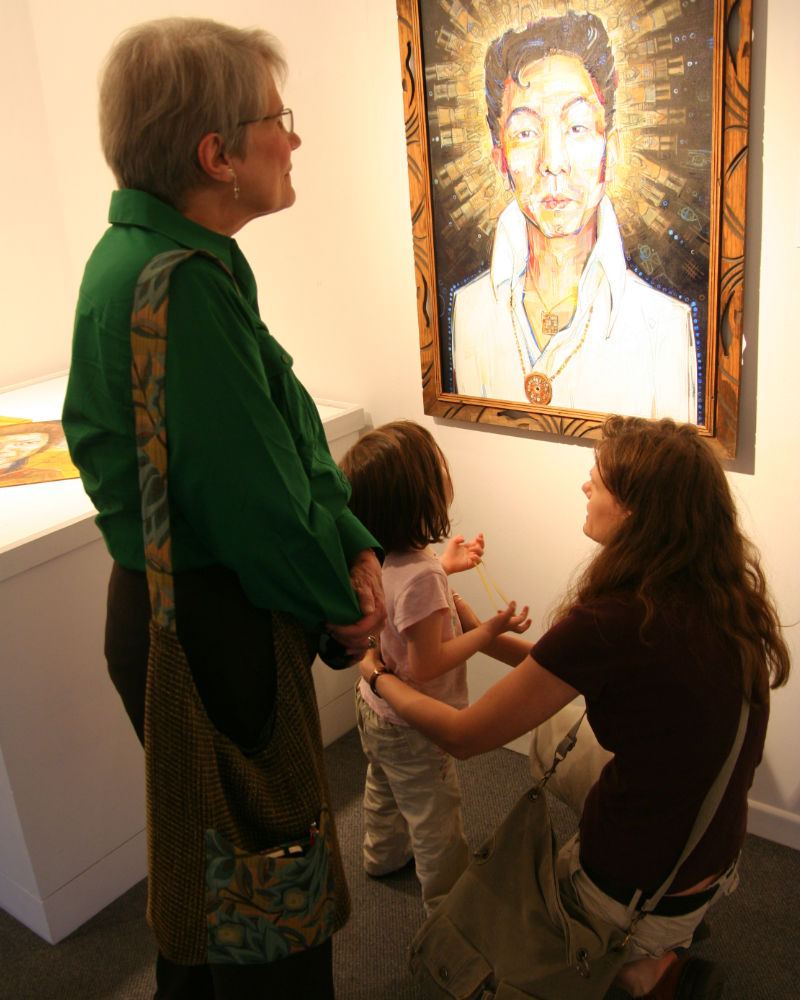Blog / 2008 / How to Show Your Art
September 27, 2008
The following are everything that should be taken into account when showing your work anywhere but in your studio. I don’t mean to imply that the venue has to have all the right (or, in other words, “most advantageous to you”) answers to these questions, only that it’s important to know where you stand on all these issues before hanging your work.
- Percentage.
- Publicity.
- Insurance.
- Installation.
- Sales.
- The artist reserves the right to use reproductions of the painting to promote her work. Should the client wish to create reproductions of the work, the artist asks that the client refrain from selling these reproductions and, instead, distribute them for free.
- The artist shall have the right to borrow the work by mutual agreement with the client.
- Party!
- Thank you.
Are you renting the wall space for a flat fee? Are you giving the venue a percentage of your sales? Or are you doing a combination of the two?
I would avoid the combination of flat fee and percentage, because, unless your work sells like hotcakes and the percentage is low, it’s probably not in your favor. Also, if a venue is asking for 40% or 50%, it should be representing you at least regionally—if not nationally and internationally. These are the percentages which professional galleries charge for actively promoting your work to collectors and museums. If the venue isn’t acting as your work’s agent, it should not get more than a 20% or 30% of your sales.
Does the venue design and print postcards or is that your job? If the venue does the postcards, what information besides your show dates and times goes on them? Are they willing to include your URL on the postcard? I would recommend asking to okay a proof of the cards before they go to print.
Also, does the venue mail the postcards out? How many people are on their mailing list? How many cards are they willing to mail out on your behalf?
Does the venue write and send out a press release or is that your job? Does the venue do anything else to promote the show?
Does the space insure your work against damage or theft at all? If so, what percentage of the retail price does it insure for?
If the venue does not provide insurance (and even if they do?), there are a few things you can do to assuage your fears about your works’ well being. Make it clear to the venue that it should touch your work as little as possible. Except in the case of an emergency, it should not move your work without your permission. Work, if two-dimensional, is safest on the wall and bad things happen to paintings when a venue takes them down to store them. If damage should occur, the space should notify you immediately so that you may evaluate what is to be done with the work. After all, you don’t want damaged work to be exhibited as a good example of what you do.
As soon as possible, establish show dates and open hours. It’s best to not do an open-ended show. Fix a close date and then extend it, but decide on an end point to begin with. This will require the venue to stay in fairly regular contact with you, which is a very good thing considering it has your work.
Set the precise dates and times for the load-in and take-down. Make sure that the venue knows that if they want to rearrange the schedule they have to give you some warning. This will avoid some of the issues addressed in #3 (like a venue moving your work to storage and inadvertently damaging it).
Also, who is responsible for physically hanging the show? While I like to choose how the exhibit will be laid out, I don’t insist on doing all the manual labor.
How will the works be lit? Who will take care of the lighting? If a work will be poorly lit, it might be better to not exhibit it at all.
Who creates the labels? What information will be included on the labels?
Do you have any special instructions for show? For example, does your work include working parts which need to be plugged in or turned on each day? Is the venue willing and also reliable enough to do this?
If the venue does take care of the sale of your work instead of simply referring potential buyers directly to you, it’s a good idea to know when you can expect your cut of the sales. Thirty days after show close is a standard window.
Also, if the venue processes transactions, what kind of sales receipt does it use? I have venues add these two terms to their standard receipts:
I’m also sure to ask the venue to provide the clients’ contact information to me. I like to thank patrons personally, and, what’s more, it’s important to keep a record of where your work goes as well as to be able to add the buyer to your mailing list.
How does the venue understand its rights to the sale of your work after the show closes? How long after the exhibition ends can it claim a percentage of the sale of a work?
If the space claims rights to your sales after the exhibition closes, it is likely trying to protect itself from artists who tell buyers to approach them after the show ends for a better deal on a piece. While I understand why artists sometimes do this, it tends to be more damaging to them than helpful. Sure, the artists see more money this way, but they also lose out on the best promotion possible. There’s nothing like a little red dot on a label at an exhibition to get people to look at work as something to be bought. The percentage paid to the venue is nothing short of an investment in future of sold-out shows.
Will there be an opening reception for the show? When? How long? What will be at the reception besides you and your work? Will there be music, a live band, a DJ? Will there be food?
Is the venue willing to host an artist talk at another time? When? Will it be catered?
Running a venue or putting up art in a non-dedicated art space is stressful and complicated. There are a lot of factors to orchestrate! It’s likely that the venue will be difficult to work with at times, but, unless it shows you or your work disrespect, I think it deserves a heartfelt thank-you.
I haven’t always had the best experiences with venues, and, so far, I would only recommend one of them without any reservations whatsoever. That said, I’ve thanked all but one of the twenty that I’ve worked with to date. To me, it’s a matter of pride in being an artist. We creative-types have a reputation of being divas or making eccentric demands that have nothing to do with the way the rest of the world works. I’m determined to change that perception of artists. I want to be treated like a professional whose time is valuable, so I make sure to treat the venues that way.
If you’d like more help navigating your art career and the promotion of your art, check out this video about how to start promoting your art or my e-book about art marketing. You can also hire me as an art guide.

Putting up a public show is a lot of work, but there’s nothing quite like seeing your audience interacting with your art!
Maybe this post made you think of something you want to share with me? Or perhaps you have a question about my art? I’d love to hear from you!
To receive an email every time I publish a new article or video, sign up for my special mailing list.
If you enjoyed this post, Ko-fi allows you to donate. Every dollar you give is worth a bajillion to me!



